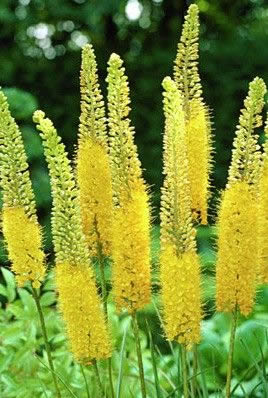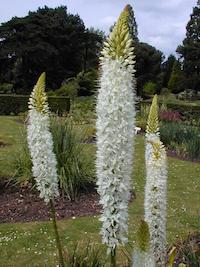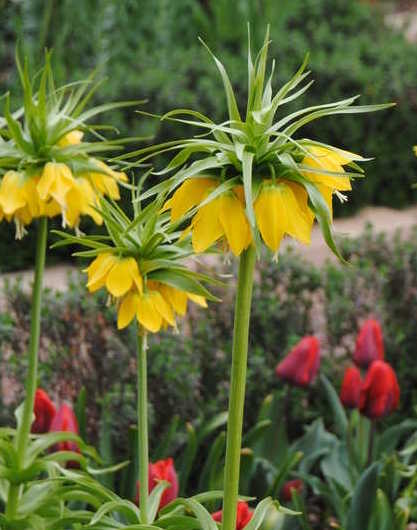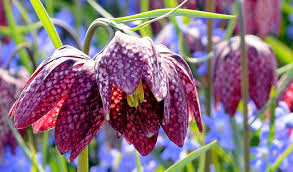A Trio of Tantalizing Spring Bulbs
By Gretchen Spencer, Fairfax Master Gardener

Eremurus stenophyllus
This time of year, most gardeners are turning their attention to starting seeds indoors, planning their vegetable gardens or researching new plants for the perennial border. However, here are three rarely planted, somewhat unusual, though tantalizing bulbs for you to think about planting next fall. You may see them on your walks around the neighborhood and wonder what they are. They are found in the genera Eremurus, Fritillaria, and Camassia. All three are deer and rodent resistant and have showy, colorful flowers that stand out in the garden. Fritillaria and Camassia are grown from true bulbs, and Eremurus is grown from a tuberous rootstock. And while each genus offers several species and varieties for the garden, I will highlight a few of the plants in each genus.
Eremurus
Perhaps the most striking of the three genera are the plants found in Eremurus. Native to dry grasslands of western and central Asia, they are known commonly as desert candles, foxtail lilies or king’s spear. Their common names refer to their flowers which grow in tall, upright racemes or spires composed of tightly packed, star-shaped flowers that open from the bottom up. Sometimes these are referred to as “bottle-brush” flowers. The bare flower stems grow from a rosette of long, grass-like leaves and generally reach 3 to 6 feet tall. The flowers bloom in May and June and come in an array of white, yellow, orange and pink. Bold and impressive, they are best planted in the back of the garden, or in front of shrubs or evergreens. Because of their height, they may require support if not planted in a wind-protected area such as against a fence or hedge.

Eremurus himalaicus
Eremurus are best planted in the fall. Their delicate, tuberous root stocks, shaped like starfish with long tentacle-like roots, should be planted in rich, well-drained soil in bright sunlight. The tubers should be planted just 2 to 3 inches deep on a cone of soil with the roots spreading out and down 2 to 3 inches. Care must be taken not to disturb the roots nor to allow neighboring plants to encroach on the roots or leaves. The crowns of the plants may be divided every few years. The plants should also be well mulched in the winter with compost or leaves to protect them from winter thaws and refreezes. The early growing leaves may be susceptible to frost damage as well as snail or slug damage.
Three species of Eremurus to consider planting are Eremurus himalaicus, Eremurus robustus and Eremurus stenophyllus. Perhaps the hardiest species, E. himalaicus has dense white flowers, grows to 4 feet and has gray-green leaves that grow up to 2 feet long. E. robustus has pink flowers, enormous flower spikes that grow 8 to 10 feet and leaves that reach 4 feet. E. stenophyllus is a dwarf species that has yellow flowers, grows 2 to 3 feet and has 1-foot leaves.

Fritillaria imperialis
Fritillaria
The genus Fritillaria contains about 100 species of unique bulbous plants that have pendant, bell-like flowers in a variety of colors, some of which are very unusual such as plum or brown. They are found throughout the world. The large bulbs have a strong, musky scent that keeps rodents out of the garden. While some species are “a bit more finicky” to grow than other bulbs, their uniqueness in the garden make them worth the challenge. The name Fritillaria comes from the Latin fritillus which means dice box and refers to the geometric patterns of spots found on some flowers that are like the dots on dice. Fritillaries also share their name with several spotted butterflies.
The species in this genus are more varied than those found in Eremurus. Here are three species that offer an interesting and intriguing alternative to or companion for more traditional spring bulbs. They may also add a conversational accent to the garden. All should be planted in full to partial sun, depending on the species, in organically rich, well-draining soil. Adding some sand or small gravel to the planting hole with help improve drainage. Fritillarias may also be bothered by red lily beetles, as they are members of the lily family. Hand picking them off is the best control. Some species may also be prone to leaf spot or rust.
Fritillaria imperialis, or crown imperial, native from southwestern Asia to the Himalayas, is an impressive 3- to 4-foot plant whose cluster of orange, yellow or red drooping bell-like flowers with spikey green leaves on top does resemble an exotic crown. The flowers rise above wavy leaves that surround the lower half of the stem. This species does best planted in full sun. The large bulb should be planted sideways to prevent water from collecting in the stem hole on the top of the bulb as the bulbs are prone to rotting. I planted ten crown imperial bulbs the previous fall, and in the spring only one bloomed beautifully, and a few others came up but did not bloom. The bulbs may have been affected by bulb rot. Nevertheless, the one that did bloom was spectacular. Bulbs usually do not bloom a second year. These bulbs may do well planted in a container with a soil mix that drains well.

Fritillaria persica
Fritillaria persica, or Persian lily, native to western Asia, bears an enchanting raceme of up to 30 bell-shaped, plum-purple flowers on strong stems that grow from 1 to 3 feet tall, surrounded with grey-green leaves. It may be planted in full sunlight but benefits from light shade during hot afternoons. There are several cultivars of Fritillaria persica. ‘Green Dreams’ grows to 3 feet and has pale plum, green-tinted flowers; ‘Ivory Bells’ grows up to 3 feet and has green-ivory flowers that mature to white; and ‘Purple Dynamite’ grows to 30 inches and has shiny, mahogany flowers that darken to purple-black.
Fritillaria meleagris, commonly called checkered fritillary, Guinea hen flower or snake’s head fritillary, grows widely in Europe from southern England to Russia. Meleagris means “spotted like a guinea fowl” and refers to the checkered pattern on its burgundy and white petals. Fritillaria meleagris is a dainty plant that grows between 6 and 12 inches tall. It has grassy gray-green leaves. The bell-shaped flowers gracefully arch downward and their checkered pattern may be in shades of maroon, dark purple, reddish purple or a muddy pink. This species grows in full sun or partial shade in moist soil and works well with other spring bulbs, provided they are planted near the front of the border. They will multiply and naturalize if their growing conditions are ideal. F. Meleagris alba is pure white with a subtle checkered pattern.

Camassia leichtlinii
Camassia
Camassia, native to western North America, with one species native to the East, is commonly known as wild hyacinth, Indian hyacinth, camas and quamash. The genus name comes from the American Indian name kamas or quamash as the bulbs were an important food source for Native Americans and settlers. It is still sought after today as a food source. All camas have tall flower spikes composed of dozens of starlike florets in vibrant shades of white, cream, blue or purple with noticeable yellow anthers that open from the bottom to the top. Plants range in height from 2 to 4 feet. They prefer moist, fertile soil and open growing conditions such as meadows or room to spread and naturalize in the garden. They will tolerate clay soils and are happy planted near ponds or in rain gardens. Once past the growing season, they will tolerate drier conditions. They will grow in full sun or dappled shade and are considered “trouble free.” An underutilized spring bulb that blooms after the daffodils, it lends rich hues of blue to the garden.
Camassia leichtlinii, commonly known as large camas or Leichtlin’s camass, grows 3 to 4 feet tall, in full sun or partial shade. In its native northwest habitat, it grows on moist mountain slopes and meadows from British Columbia to southern California. There are several cultivars available for the home garden. All will naturalize if left undisturbed, forming showy clumps. ‘Alba’ has racemes of creamy white star-shaped flowers. ‘Caerulea’ has pale to deep lavender-blue flowers, and ‘Pink Stars’ has pale pink florets on its upright stems.
Camassia cusickii, commonly known as Cusick’s camass, is native to northeast Oregon and western Idaho, and is cultivated widely for home gardens. From its rosette of grassy leaves, the flowering stalk grows to 2 1/2 feet and bears sky blue to white flowers with prominent yellow anthers.
Camassia scilloides, commonly known as wild hyacinth or Eastern (Atlantic) camas, is native to central and eastern United States. Reputed to be rare in Virginia, a search of the Internet showed several plant nurseries that offer it for sale. Native to a variety of habitats, it has fragrant pale blue flowers and grows from 1 to 2 feet tall. The epithet scilloides refers to its similarity to the genus Scilla.
With the spring and summer growing seasons soon to be here, keep one or more of these unusual but stunning plants in mind to order in the coming fall. They will certainly add flair and elegance to your spring garden. There are numerous bulb catalogs that offer these more unusual plants.
Resources
• Essential Perennials: The Complete Reference to 2700 Perennials for the Home Garden, by
Ruth Rogers Clausen and Thomas Christophe
• Foxtail Lily, Chicago Botanic Garden
• Eremurus, Royal Horticultural Society Gardening
• Consider Fritillaries This Fall, Dr. Leonard Perry, University of Vermont
• Fritillaria meleagris, Missouri Botanical Garden
• Fritillaria persica, Missouri Botanical Garden
• Guinea Hen Flower, Fritillaria meleagris, University of Wisconsin Extension
• Camassias, Cathy Caldwell, Piedmont Master Gardeners
• Camassia leichtlinii, Missouri Botanical Garden
• Camassia scilloides, Missouri Botanical Garden